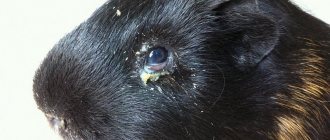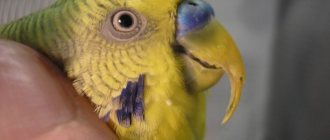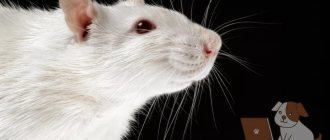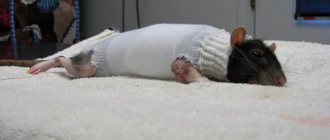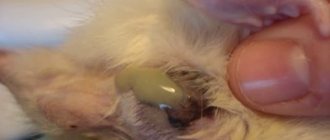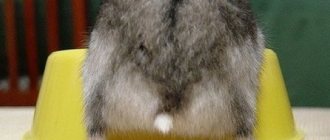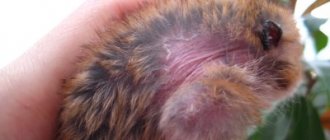Pets can also get sick, including various skin diseases. More often, hamsters experience baldness for various reasons, allergic dermatitis and, less commonly, lichen.
Ringworm in a hamster manifests itself in the form of bald areas of skin, itching and scabs from scratching.
To make an accurate diagnosis, it is important to contact a veterinary clinic, because the disease is infectious in nature and does not go away on its own.
The specialist will determine whether this disease can be dangerous for humans and will suggest how to treat the animal by selecting the appropriate medications.
Domestic rodents are susceptible to several types of fungal skin infections:
- scab;
- dermatophytosis;
- ringworm.
They all have similar symptoms and are infectious in nature, and the last two are contagious to humans.
Lichen
This is a skin disease caused by a viral infection or microscopic fungi. Depending on the pathogen, there are two types of lichen: ringworm and pink lichen.
Rodents with weakened immune systems, mechanical trauma to the skin, and elderly animals are at risk of infection.
The following symptoms are typical for lichen:
- baldness;
- the appearance of inflamed areas;
- itching;
- loss of appetite.
If the disease is confirmed, the sick hamster is isolated from other pets, the cage, bowls, wheel and all objects that came into contact with the infected animal are disinfected. The most effective means for this will be a formaldehyde solution or a sulfur-carbolic mixture.
For treatment, antifungal drugs are used, which are prescribed by a specialist, who will also tell you the dosage and duration of the course. Hair is removed from damaged areas of the body as they are contaminated with fungal spores.
Dried crusts are softened and cut off, the area is treated with salicylic ointment, and the edges are treated with iodine. It is also recommended to support your pet’s body with immunostimulating drugs and probiotics during the treatment period.
Ringworm
A characteristic feature is rounded bald patches on the front of the body and muzzle.
Further, these bald spots become inflamed and form purulent ulcers, through which the fungus enters the body, poisoning it with toxins and causing itching throughout the body.
The disease is transmitted from humans to animals and vice versa.
Pityriasis rosea
The main difference from other skin diseases is the appearance of hairless pink areas of skin, more saturated at the edges than in the center.
It is not dangerous for humans - unlike trichophytosis (the scientific name for ringworm), it is not transmitted through household contact.
Fungal diseases of hamsters: symptoms and treatment
Fungal diseases of hamsters: symptoms and treatment. Infections caused by spores of various types of fungal flora. Diagnosed only by veterinary specialists. Ratologists at the Vetmaster veterinary center will help diagnose fungal infections and prescribe correct and effective treatment for your pet, which consists of local and systemic antifungal therapy and immunostimulation of the animal’s body. Of the existing fungal infections, the most common are:
Actinomycosis. It is caused by the so-called radiant fungus of the genus Actinomyces, which enters the hamster’s body with infected cereal plants. Symptoms: damage to the bones and muscles of the jaws, gums and teeth, the junction of the incisors is displaced and they are worn incorrectly, discomfort occurs while eating.
Dermatophytosis. Caused by fungi of the genus Trichophyton and Microsporum. Dangerous for humans. Symptoms: gray, dry, flaky patches of baldness on the rodent’s body, itching, scratching.
Scab. Caused by a fungus of the genus Achorion. Symptoms: loose, abundant peeling in the ears and eyes, the presence of gray small blisters, then crusts and sores, itching, scratching.
Scab
The causative agent is the fungus Achorion Schoenleini. Hamsters get the disease through contact with sick animals or humans, through insect bites and contaminated equipment.
It looks different depending on the stage of development.
Main symptoms:
- white scaly plaque on the ears, eyebrows and tip of the nose;
- formations are round in shape with a diameter of up to 1 cm;
- Over time, the affected areas become covered with blisters, which gradually increase in size and form crusts with hairs in the middle.
A sick animal must be isolated from other pets, the room and objects with which it has been in contact must be treated with disinfectants.
Establishing an accurate diagnosis will allow the veterinarian to select an antifungal drug, establish the dosage and course of treatment. It is also necessary to treat the affected areas of the skin - scales and scabs should be softened with oils and carefully removed.
Treat areas cleaned of crusts daily with iodine tincture mixed with alcohol solutions of glycerin, creolin or Lysol.
Household problems in rats and other rodents
Domestic rodents have a number of advantages, for example, they are smart (especially rats), but at the everyday level they have plenty of problems. Among them:
- Rodents chew (forgive the tautology) almost any thing, so you need to be careful with your things;
- Your pet's cage will need to be cleaned frequently;
- Rodents are predominantly nocturnal, so their noise at night will disturb people with light sleep;
- A rodent's cage usually needs to be spacious, which is why it often takes up a lot of space. Putting it in a secluded corner will not work;
- If you get a rat, then you risk becoming an object of ridicule and teachings like “they were the reason for the plague”;
- And finally, rodents live very little even with ideal care, that is, no more than 5 years, with rare exceptions.
Dermatophytosis
A skin disease caused by dermatophyte fungi that feed on hair and dead cells. The infection is also known as ringworm because the red lesions appear in rings on the skin.
There is severe peeling along the edges of the spots, while the surface in the center is absolutely healthy.
Dermatophytosis poses a threat to households - it can be transmitted from animals to humans.
Treatment is selected by a specialist, usually using external agents such as Yam or Fungin ointment, Zoomekol aerosol, chlorhexidine, and sometimes oral medications. The duration of therapy is 1-2 months.
Don’t forget about disinfecting the premises – fungal spores are viable for up to 4 years.
What to do
If changing the bedding, good care and a nutritious diet have not stopped the hamster’s hair loss, then a visit to the veterinary clinic is essential. Unfortunately, not all doctors undertake to treat rodents.
Try to find a blade that has a specialist - a ratologist.
If there is no such hospital, the Internet will come to the rescue. Post good photographs of your pet on specialized veterinary websites, describe the problem in detail and get qualified advice.
Fleas
They are extremely rare in hamsters; infection mainly occurs from other domestic animals - cats or dogs.
If your pet develops itching, skin rashes, baldness over large areas of the body, dandruff, and crusts, a flea infestation can be suspected. In this case, it is necessary to take urgent measures to eliminate them.
Anti-flea medications used for dogs and cats are not suitable for hamsters and can be harmful to their health. To get rid of fleas, special antiparasitic agents for rodents are used.
Viral diseases or fungus
We correctly determine the cause
You can often hear the question of why a hamster's hair falls out. Experienced experts say that this may be a consequence of a fungus or virus. The symptoms of such diseases are that the skin begins to peel off or hair loss occurs.
In order to get rid of such signs, you should buy a special ointment. It is not difficult to buy it at a specialized veterinary pharmacy or from a doctor. It should be smeared on sore areas of the skin. To prevent the recurrence of the disease, it is recommended to use the ointment even after the unpleasant symptoms have disappeared.
Article on the topic: How long do Syrian hamsters live at home?
Ticks
Ectoparasites on a hamster are quite common, but they do not bother the animal, since their number is usually small.
For a clear clinical picture of the disease to appear, they must be accompanied by vitamin deficiencies, weakened immunity, or poor hygienic conditions.
Causes and symptoms. Rodents are most often affected by Demodex mites, which are the causative agents of demodicosis.
With this disease, the pet experiences itching, dandruff, increased hair loss, dry and irritated skin.
Hamsters are often parasitized by Notoedres mites, the causative agents of notoedrosis.
This pathology is characterized by severe itching, hair loss, and the formation of dry crusts and dandruff on the face, ears, cheeks and limbs.
To get rid of itching, animals itch, the skin is damaged, and this leads to infection.
Rodents become irritable, refuse food - the result is exhaustion, which can be fatal.
Another type of scabies is caused by the scabies mite Sarcoptes anacanthos. With sarcoptic mange, pets itch severely, damaging the skin and infecting the wounds.
Pustules form throughout the body, which turn into scabs and scabs.
Without timely and effective help, a small pet may die 3-4 weeks after the first symptoms appear.
To get rid of ticks, use local preparations in the form of powders, sprays, ointments, shampoos with selenium sulfide or oral insecticides. Diagnosis and treatment should be carried out by a veterinarian.
The drugs metrifonate and cythioate showed good results. For sarcoptic mange, infected animals are bathed in a 0.5% bromocyclene solution.
To cure a hamster from notoerdrosis, the affected areas should be treated with a 3% solution of the drug SK-9, sulfur ointment, the course of recovery is 7-10 days.
In case of bream, the pet must be isolated from other individuals, and the cage and objects with which it has been in contact must be disinfected. This will prevent re-infection.
Common Hamster Diseases
It is worth raising the question of the most common diseases found in hamsters, their symptoms, outcomes and possible ways to resolve them safely.
Vitamin deficiencies. Due to a lack of necessary sources of vitamins in the diet, hamsters develop various, in some cases, irreversible pathologies. The range of symptomatic manifestations of these pathologies is different: weakness, problems with gums and teeth, problems with the eyes and skin, problems with joints and skeletal muscles, dysfunction of the gastrointestinal tract and central nervous system.
If these symptoms appear, you should immediately contact your veterinarian. The task of our specialists is to correctly recognize and diagnose the type of pathology, select the appropriate treatment and adjust the animal’s diet in order to avoid such problems in the future.
Infectious diseases of hamsters: symptoms and treatment. They are caused by pathogenic micro-agents (bacteria and viruses) that can enter the body from sick animals, through the bite of various insects, through contaminated food, water, and care items.
Bronchosepticosis. Bacterial infection transmitted by airborne droplets. Symptoms: runny nose, serous-mucous or ichorous discharge from the nasal cavity, sneezing, snorting, tousled hair, loss of appetite, wheezing in the lungs. Treatment: keeping healthy hamsters isolated from sick ones, sulfa drugs are prescribed, drug dosages are prescribed only by a veterinarian!
Pasteurellosis. Routes of infection are airborne and contact. Symptoms: runny nose, septic phenomena, hemorrhagic inflammatory processes, pneumonia. Treatment: with timely treatment, the administration of penicillin antibiotics is effective.
Pneumonia. Viral infection. The route of infection is airborne. Symptoms: pneumonia occurs, apathy, wheezing, the animal does not eat, breathing is heavy, frequent, cough, purulent discharge from the nose and eyes. Treatment: Prescription by a veterinarian of oxytetracyclines, sulfonamide drugs and vitamins.
There are many acute respiratory infections in rodents. The symptoms are very similar to some of the symptoms of other infections, so it is recommended to consult a veterinarian for proper diagnosis and appropriate treatment. At Vetmaster, qualified specialists and the modern diagnostic facilities of the veterinary center will help you with this.
Enteritis. Mixed infection caused by bacteria of the genus Escherichia and Campylobacter. The route of infection is contact. Symptoms: refusal to eat, watery diarrhea, increased general body temperature. Treatment: neomycin, tetracycline, enterosorbents, as a rule, treatment is ineffective due to the fulminant course.
Unfortunately, there are a number of infections, the terminal stage of which is the death of the rodent, the treatment of these infections is usually ineffective, these are diseases such as rabies (occurs extremely rarely), Aujeszky's disease, Tyzzer's disease, collibacilosis, lymphocytic choriomeningitis, listeriosis, pseudotuberculosis, paratyphoid fever, or salmonellosis, tularemia, viral encephalomyelitis. For detailed information about these diseases and consultation, you can contact a specialist ratologist at the Vetmaster veterinary center.
Prevention measures
To avoid infection with skin diseases, as well as to prevent relapses, you must adhere to the following recommendations:
- nutrition should be balanced;
- the water in the drinking bowl should be changed regularly so that it is always fresh;
- hygiene rules must be observed;
- periodically treat the premises with disinfectants;
- carry out vaccinations against major serious diseases.
These simple rules will support your pet’s immunity and prevent infection from developing.
Secondary alopecia
Abscess
If limited purulent inflammation occurs, the skin in this area becomes thinner and the hair falls out. Baldness is accompanied by a change in skin color, the focus fluctuates when palpated. An abscess in a hamster opens spontaneously or in a veterinary clinic.
In addition to surgical treatment, a course of antibiotics and daily washing of the wound with an antiseptic are required. Prescribe “Baytril 2.5%” 0.4 ml per 1 kg of body weight (0.06-0.1 ml for Syrians and 0.02 ml for dwarfs). Subcutaneous injections, 1 time per day, 7 days.
The fur grows back after the purulent inflammation stops.
Urine irritation
If your hamster's hind legs and tummy are bald, this indicates constant skin contact with urine. Infrequent bedding changes and a small cage will cause this phenomenon, but if the pet is kept properly, hair loss on the pelvic limbs is a sign that the hamster drinks a lot and pees a lot. Polyuria
– a symptom of various diseases:
- Cystitis (inflammation of the bladder);
- Urolithiasis disease;
- Kidney failure;
Mechanical abrasion of wool
Under unsuitable conditions, thick fur may fall out due to constant mechanical stress. This is how the hair on the paws and tummy is wiped, but most often on the head if the hamster has a bad habit of gnawing on the bars of the cage. The bald spot on the nose will not heal until the pet stops sticking its muzzle through the bars.
If it is not possible to move the rodent from a lattice cage to a terrarium, you need to offer it another object for grinding down its constantly growing incisors. Twigs, treats for hamsters in the form of hard sticks, mineral stone. The animal should not be humanized, believing that it is trying to break free.
Hormonal alopecia
Sometimes, to understand why a hamster is bald, the animal needs an ultrasound. This is not possible in every clinic. An experienced ratologist can assume disruptions in the hormonal system if baldness is observed in a female, and the bald spots on the back are symmetrical. Hamsters have:
- Polycystic and;
- Endometritis, pyometra (inflammation of the uterus).
A female can also go bald during pregnancy. The belly of a nursing hamster becomes completely naked during lactation.
Shedding
Bald spots may be a sign of a natural process for hamsters -. Baldness usually affects the stomach and inner thighs, but sometimes hair falls out on the back.
Old age
Causes of hair loss
They can be divided into two categories: natural and pathological shedding.
The pet is healthy, active, eats well, but the fur is very loose.
Seasonal shedding - old wool is replaced by new. Occurs intensely on the abdomen and the inside of the legs, and almost imperceptibly on the back.
Age - on average, hamsters live three years, a two-year-old rodent is already considered old, and it is quite natural that he began to go bald.
Hormonal changes – during pregnancy, females can experience intense hair loss. Also, bald spots on the abdomen appear in hamsters that feed their young.
Sometimes hair loss can indicate health problems or improper care. The causes of baldness should be excluded and checked in order:
Filler - some of them can cause an allergic reaction in a rodent.
Nutrition - it must be balanced with all the necessary elements so as not to cause vitamin deficiency. Sometimes hamsters develop intolerance to some fruit or vegetable, it is worth finding out by elimination.
Stress – constant change of environment can lead to baldness.
Diseases are one of the most dangerous causes. Only a specialist can make a diagnosis and prescribe effective treatment.
Why does shedding occur?
All animals sooner or later begin to change their fur. Hamsters are no exception. This can occur for several reasons.
- Due to age. The bottom line is that at the age of 5 months, hamsters can change their fluffy fur to denser hair (molting is observed).
- Due to seasonal processes. Hamsters shed only in spring and autumn. This is due to the fact that weather conditions are changing.
Article on the topic: Why does the shell of a red-eared turtle darken or turn green
? Usually, the molting process cannot be seen with the naked eye. If your rodent is not sick and is quite active, then there is no need to worry. This is a normal physical process that cannot be influenced. For example, small Djungarian hamsters have only three coat colors. As soon as they “survive” the moult, the number of shades doubles.
